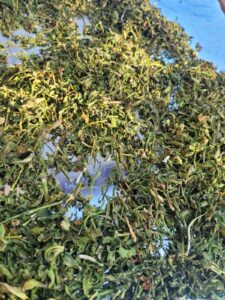Hello friends! It’s Irwin here, and today, I’m diving into something that might sound a bit scientific but is super important for anyone on a health journey: the difference between pro-oxidative and anti-oxidative processes. We’ll also take a look at how these concepts apply to chemotherapy and certain herbs, especially in the context of cancer treatment. 💪✨
Pro-Oxidative vs Anti-Oxidative: What’s the Deal?
To break it down, oxidation is a chemical process in which molecules lose electrons, often producing free radicals—unstable molecules that can cause damage to cells, proteins, and DNA. This damage is known as oxidative stress, which is linked to aging, inflammation, and diseases like cancer.
•Pro-oxidative agents promote oxidation and increase free radical production, leading to oxidative stress.
•Anti-oxidative agents, or antioxidants, work to neutralize free radicals, reducing oxidative stress and protecting cells from damage.
Now, here’s where things get interesting. While we usually think of oxidative stress as harmful, it can also be therapeutic in certain contexts, like in cancer treatment. Let’s explore that more.
Chemo: A Pro-Oxidative Powerhouse 💥🧬
Did you know that many chemotherapy drugs are pro-oxidative? Yup! The main idea behind chemo is to kill cancer cells, and it does this by inducing oxidative stress in those cells. Chemo generates reactive oxygen species (ROS) that damage the cancer cells’ DNA, proteins, and other cellular structures, essentially forcing them to self-destruct through a process called apoptosis (programmed cell death).
But there’s a catch. While chemo targets cancer cells, it also affects healthy cells, causing those nasty side effects like fatigue, hair loss, and nausea. This is because the oxidative stress doesn’t discriminate between cancer cells and healthy cells. So, even though chemo is pro-oxidative, it’s not always selective, and that’s what makes it a bit of a double-edged sword.
What About Herbs? Pro-Oxidative in Cancer Cells, Antioxidant in Healthy Cells? 🌿✨
Now, let’s talk about nature’s pharmacy. Many herbs are known for their antioxidant properties, protecting our cells from oxidative stress. However, some herbs can also exhibit pro-oxidative effects—but only in cancer cells. That’s right! Certain herbs can selectively induce oxidative stress in cancer cells, helping to destroy them while sparing healthy cells. Here are some of the key players:
1. Typhonium flagelliforme (Rodent Tuber)
This Southeast Asian herb has shown both antioxidant and pro-oxidative effects. Studies suggest that Typhonium flagelliforme can selectively increase ROS in cancer cells, leading to cell death while protecting normal cells from damage In silico and in vitro Characterizations of Rodent Tuber (Typhonium flagelliforme) Mutant Plant Isolates against FXR Receptor on MCF-7 Cells. This herb is like a targeted weapon against cancer cells, using oxidative stress to get the job done.
2. Curcumin (from Turmeric)
Curcumin is well-known for its antioxidant properties, but in cancer cells, it flips the script by generating ROS and promoting oxidative stress. This damages cancer cells while leaving healthy cells unharmed. It’s like a smart bomb for cancer therapy.
3. Green Tea (EGCG)
The active compound in green tea, EGCG, has been shown to induce oxidative stress in cancer cells, causing them to die. Meanwhile, it acts as an antioxidant in normal cells, making it an ideal candidate for cancer prevention and treatment.
Why Does This Matter?
Understanding the pro-oxidative vs anti-oxidative roles in cancer treatment is crucial for anyone going through cancer or supporting a loved one through it. While chemo is a powerful pro-oxidative treatment, natural solutions like herbs can offer a more targeted approach, killing cancer cells with oxidative stress while protecting healthy cells.
This balance is key to developing complementary therapies that work hand-in-hand with conventional treatments. Imagine the possibilities—using herbs like Typhonium flagelliforme or curcumin alongside chemo could potentially reduce side effects while boosting effectiveness. But as always, consult with your healthcare provider before adding herbs or supplements to your treatment plan.
Wrapping It Up: The Best of Both Worlds
In summary, both pro-oxidative and anti-oxidative actions have their place in cancer treatment. Chemo uses pro-oxidative stress to kill cancer cells, while herbs like Typhonium flagelliforme can offer a more selective, natural way to do the same. Balancing these forces might just be the key to more effective and less harmful cancer therapies.
As someone who’s walked the cancer journey, I’m always looking for ways to blend the best of both worlds—science and nature—so we can live healthier, stronger lives.
Stay strong, stay informed, and remember, there’s always hope! 🙏💖
Feel free to DM me if you have any questions about cancer treatments or want to chat more about herbs and natural remedies. Together, we can explore the best ways to heal and thrive.



No comment yet, add your voice below!